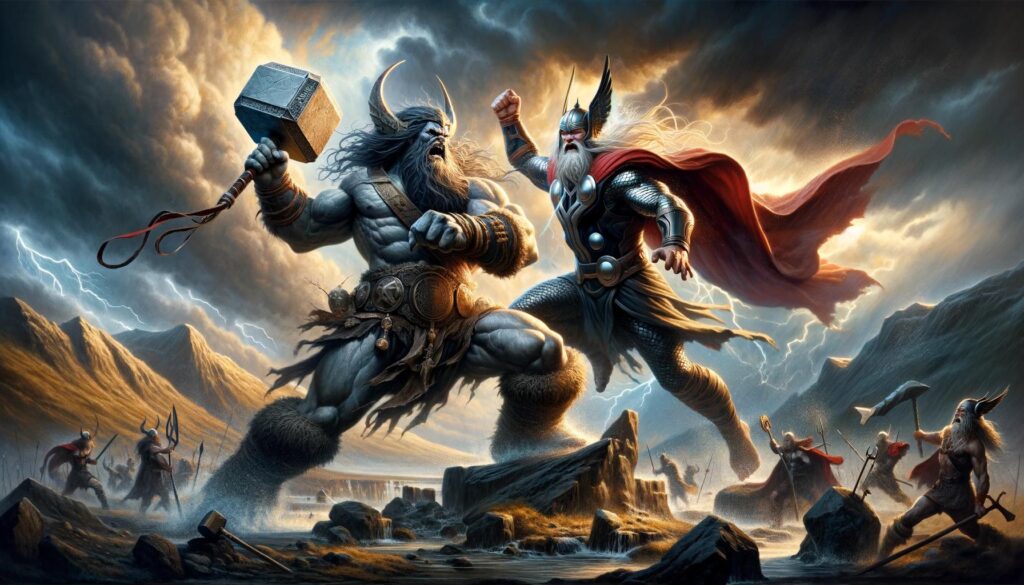Creatures in Norse mythology, Giants (Jötunn), Hrungnir, Norse Mythology, Tales of the Gods, Thor
Hrungnir: The Mighty Jotunn and His Duel with Thor
Introduction
In Norse mythology, the giants known as Jotnar or Jotunn are powerful and often malevolent beings that frequently clash with the gods of Asgard. Among these formidable giants, Hrungnir stands out as one of the most memorable figures due to his immense strength and his legendary duel with Thor, the god of thunder. This article delves into the intriguing story of Hrungnir, his origins, his fateful encounter with Thor, and the significance of this epic clash in Norse mythology.
The Birth of Hrungnir
Hrungnir, often called “The Stone-Headed Giant,” was unlike the typical giants in Norse mythology. He was unique in both appearance and temperament. Hrungnir was said to have a head made entirely of stone, giving him an imposing and distinctive presence among the Jotnar. He hailed from the land of the giants, Jotunheim, which was a realm separated from Asgard by the Bifrost, the Rainbow Bridge.
Hrungnir’s creation myth varies in different sources, but one popular version states that he was born from the sweat and blood of a primordial frost giant, Ymir. As such, Hrungnir was seen as a direct descendant of Ymir, making him a formidable force to be reckoned with.
Hrungnir’s Character and Abilities
Hrungnir was known for his fierce and reckless nature. He was often depicted as brash and impulsive, traits that frequently got him into trouble. Despite his aggressive tendencies, he possessed incredible strength and endurance, making him a formidable opponent even among the giants. He was also said to be an accomplished practitioner of magic, and he was known to have a penchant for challenging the gods of Asgard.
One of Hrungnir’s most distinctive characteristics was his heart, which was also made of stone. This heart was said to be his only vulnerable spot and played a crucial role in his eventual downfall. The legend of Hrungnir and his heart of stone would come to prominence during his encounter with Thor.
The Duel of Hrungnir and Thor
The story of Hrungnir’s epic duel with Thor is one of the most famous episodes in Norse mythology. It all began when Hrungnir, emboldened by his immense strength and perhaps a touch of arrogance, challenged the gods of Asgard to a contest. He rode his mighty steed, Gullfaxi, to Asgard and demanded a race. Knowing the consequences of refusing a Jotunn’s challenge, the gods agreed.
As the race began, Hrungnir and his steed raced against none other than Thor and his famed goat-drawn chariot. Despite Hrungnir’s great speed, Thor’s divine strength and the thunderous power of Mjölnir allowed the god of thunder to emerge victorious. Hrungnir, fueled by frustration and anger, swore vengeance upon Thor for his humiliation.
The Jotunn’s anger did not subside, and he later made his way to the halls of Asgard, demanding a duel with Thor. The gods, fearing the repercussions of declining such a challenge, accepted Hrungnir’s request. The stage was set for an epic clash between the mighty Jotunn and the god of thunder.
The Duel Unfolds
The duel between Hrungnir and Thor was a spectacle that would be remembered for ages. Hrungnir wielded a massive whetstone, a formidable and heavy implement, as his weapon of choice. Thor, on the other hand, grasped his trusty hammer, Mjölnir, which was known for its destructive power.
The battle raged on, with the earth shaking beneath their feet as each blow landed. Hrungnir was no easy adversary, and Thor struggled to gain the upper hand. In a moment of desperation, Hrungnir hurled his massive whetstone at Thor with all his might. The impact was cataclysmic, as the stone collided with Mjölnir mid-air, shattering the hammer and sending its fragments flying.
Thor’s Cunning Victory
Now disarmed and facing a formidable enemy, Thor had to rely on his wits to emerge victorious. In a cunning move, Thor picked up a piece of Mjölnir’s shattered handle and hurled it at Hrungnir’s head. The fragment struck Hrungnir’s stone head, shattering it into pieces and ultimately killing the mighty Jotunn.
However, Thor’s victory came at a cost. The fragment of Mjölnir’s handle had lodged itself in Hrungnir’s heart, and the god of thunder was unable to remove it. As a result, Thor was afflicted with lingering pain and discomfort, a reminder of the fierce battle with the stone-headed giant.
Thor’s Lingering Pain: A Reminder of the Duel
The Significance of the Duel
The duel between Hrungnir and Thor carries significant symbolic weight in Norse mythology. It underscores the constant struggle between the gods and the giants, highlighting the god’s triumph over chaos and destruction. It also reminds us that even the mightiest foes can be defeated through cunning and resourcefulness rather than sheer brute force.
Hrungnir’s heart of stone, which played a pivotal role in his defeat, symbolizes the idea that even the most powerful adversaries have vulnerabilities. In this case, Hrungnir’s own reckless nature ultimately led to his downfall.
Legacy of Hrungnir in Norse Mythology
Conclusion
Hrungnir, the stone-headed giant of Jotunheim, left an indelible mark on Norse mythology through his epic duel with Thor. His character, abilities and the circumstances surrounding his demise provide valuable insights into the complex and rich tapestry of Norse mythology. The tale of Hrungnir and Thor’s clash serves as a timeless reminder of the struggle between order and chaos and the importance of wit and strategy in overcoming seemingly insurmountable obstacles. Though Hrungnir may have been a mighty Jotunn, in the end, he was defeated by the cunning and resilience of the gods of Asgard, solidifying their place as the protectors of the nine realms.

